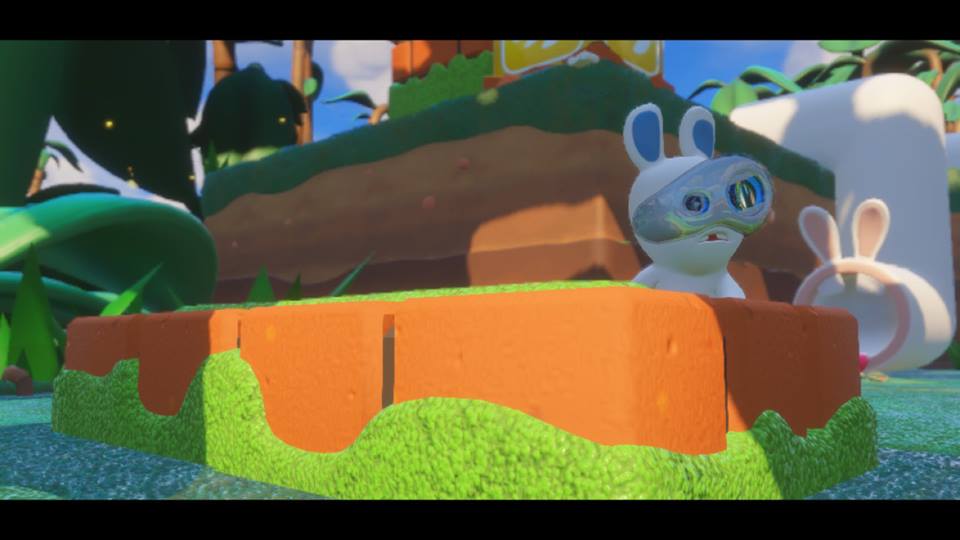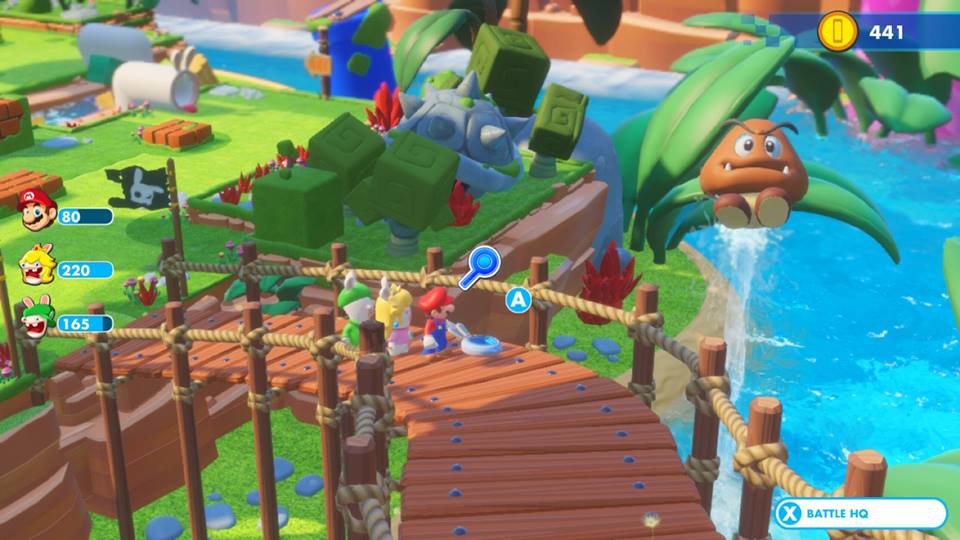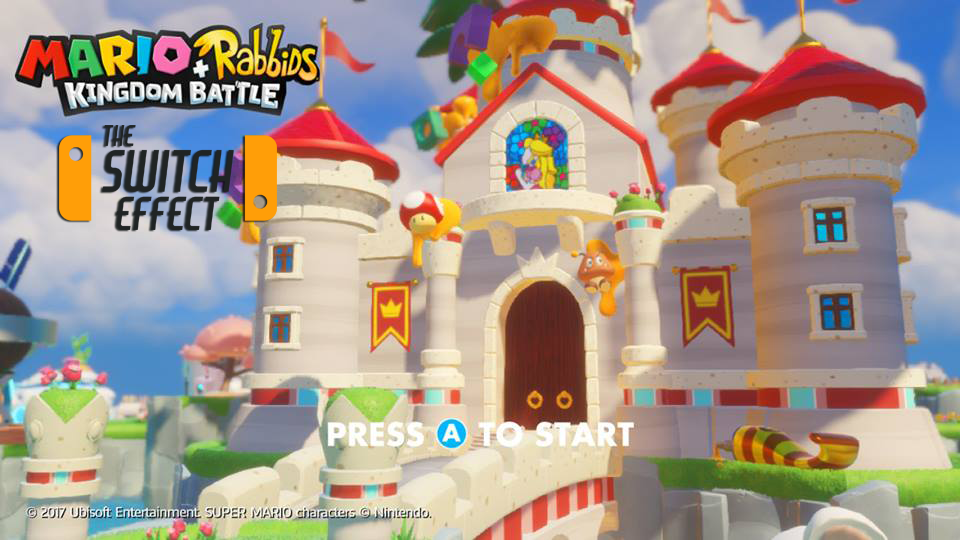[Review] Mario + Rabbids Kingdom Battle – Nintendo Switch

Mario + Rabbids Kingdom Battle
Developed By : Ubisoft Paris
Published By : Ubisoft
Category: Adventure, Strategy
Release Date : Aug 29, 2017
For as long as I can remember, I have always been into puzzles. Whether it’s reading mystery books, watching crime shows and movies, even just sitting and doing actual puzzles. So it’s a wonder that, until the past year, I’ve never enjoyed playing turn-based strategy games. It’s not necessarily a puzzle in the same form, but it works the same. You have a start point, a grid, and a number of enemies or objectives, and you need to figure out how to move around to complete your task. Again, not exactly the same, but I think you see my point. Yes? No? Well, either way we’re going on…
I caught a stream of Mario + Rabbids soon after it was released. I’d seen a couple ads for the game, but nothing that really dove into the details on it, so I was completely in the dark as to what the game was about. When I was watching my friends stream, and saw that it was a turn-based strategy game, in that moment I just knew that if any game was going to get me into this genre, it had to be this one.
Boy was I right about that.

Story
An inventor has created a device dubbed as SupaMerge, a helmet with the power to fuse two things into a single item, with the assistance of their robot Beep-O. While the inventor is out of the room, a swarm of Rabbids appear in their time-travelling washing machine, and begin causing chaos in the invention room. One of the Rabbids dons the helmet and begins fusing things like crazy. Things really hit the fan when the SupaMerge hits the washing machine, and a poster of Mario and his friends. It creates a vortex, shooting the Rabbids into the Mushroom Kingdom where they begin to run rampant. The helmet-wearing Rabbid continues to fuse everything in sight, and it is up to our team of heroes (Mario, Luigi, Peach, and Yoshi, in both actual form and Rabbid-fused form) to stop things before they get worse. However, Bowser Jr. comes across everything, renames the helmet-wearer “Spawny”, and recruits him to cause even more insanity, all just to make his father proud. Can our heroes save the day once again?

Gameplay / Controls
In a massive shift for anything with the name “Mario” in it, the gameplay moves far away from platforming, bringing a big focus to tactical, turn-based combat. You’ll wander freely through the worlds, able to explore any areas and side-paths you come across, solving puzzles and earning weapons and in-game collectibles, but that’s only between battles.
Battles are the main focus of the game. They take place in locked, gridded areas which are denoted by a pair of black flags as you approach the area. Once you’re in, it feels like just about anything can happen.
You’ll enter battle with a team of three characters, and each characters turn will consist of up to three phases. You can move around, shifting to a new cover or finding higher ground; you can attack with either your main gun weapon, or with a special secondary weapon (which I will get more into later); the last phase is one that may or may not always occur, and I’ve taken it to calling it the “buff” phase”. (I realize now as I’m writing this it could simply just be called post-combat…but that’s no fun). Each of your team members will go through these, and once you’ve completed it all, your enemies can do the same if any of them remain standing.
Everything you do is represented by a grid. The battlefield itself has it’s limits, as do each of your moves, so let’s talk a tiny bit more about each phase. Your moving phase is simple, there’s a specific amount of cells to which your range expands. However, this is a little bit different than most other strategy games. In most other games, your character has a number of cells they can move. Yet, in Kingdom Battle you get a decent sized open space, and you can go all over it if you choose. This means you can cross your range entirely, hit an enemy with your Dash attack, run all the way back to where you started to jump off a teammate, before finally landing somewhere else entirely. I was a huge fan of this because it gave the feel of a bit more freedom during your turns. Also, yes, I did mention a couple of other moves you can perform. Dash attacks are when you select a cell containing an enemy, your character will perform a power-slide into them : a move that can be performed every single turn and effectively giving you a second attack per turn. Team Jump is a way to reach different areas, as some battlefields contain both high and low ground. There’s usually a pipe to get to higher ground, but if a teammate is close enough you can just jump straight up there.
Combat and “buff” phases (I’m sticking with it) are a lot simpler. Your weapons have a set-range that they can reach, so if no enemies are close enough you won’t be able to do anything. If they are close, your accuracy can be effected by whether or not they’re behind cover like a wall or box. Boxes are not always in the battles, but can be provide some fun boosts. These can trigger some sort of effect like exploding and causing burn damage, bouncing your enemy and potentially knocking them off the stage, or if they’re filled with honey it can delay anything your enemy was intending to do for at least a turn. Attacking from higher ground will also grant a boost to the damage you deal. Secondary weapons, which I mentioned above, differ for each character. Mario’s, for example, is a melee hammer (Paper Mario anyone?) but he has to be super close an enemy, while Luigi has a sort of RC mini-tank that will travel to an enemy before exploding. The buff phase is just a matter of selecting an effect to occur. Some characters can attack a moving enemy if they come within range, others can heal party members (also within range), or give themselves a defense boost. It is worth noting that secondary weapons and the buff effects all have cooldowns, so use these sparingly.
Since it’s turn-based strategy, the controls are quite simple.
Left/Right Joystick : Move / Adjust camera
L/R : Switch active character (in battle only)
ZL/ZR : Switch between Moving/Attack/Buff on active character (in battle only)
A/B/Y/X : Select option / Cancel option / Activate Easy Mode for a battle / Use Tacticam (in battle) Enter Battle HQ (out of battle)
With the game not carring the same platforming focus as the majority of most titles, the controls don’t need to be as intuitive. Everything is very point-and-click, even when in a puzzle area. Simply approach a block and press A to move it, or determine where in battle you want to move and press A to go there.

A Bit of Everything Else
Outside of battles and pummeling your foes, Kingdom Battle does offer some extras. The one that ties in the most with the main game itself is Battle HQ. Here, you can swap your active team members in and out, purchase new weapons (which must first be found in the game before you can buy them with coins, also found in the game), and fill up everyone’s skill tree. Each characters skill tree is specific just for them, but some items may be the same or extremely close between characters. You purchase upgrades by using power orbs, which can be won in battle or found in chests hidden in the levels.
Everything else is housed around Peach’s Castle. As you progress in the game, some of the more friendly Rabbids will do some construction, popping up a handful of buildings just outside of the castle’s moat. These include an actual physical location for the Battle HQ, a Museum to show off some of the figures you can collect in the game, an amiibo factory (to unlock additional weapons and multiplayer challenges), the Buddydome for multiplayer action, and you can even use the Rabbid’s own Washing Machine  to replay levels, gaining you access to further areas when you unlock newer skills.
to replay levels, gaining you access to further areas when you unlock newer skills.
The multiplayer is broken up into single challenges in which each player controls their own team, and they must work together to complete the objectives. It doesn’t alter much of the gameplay other than making things a bit bigger and the battles going on a little longer, However, it did leave me curious as to how different it would be if instead, the two players (or even three) could be on the same team, locked into controlling one single character.
Overall
In the end, what your left with is one hell of a phenomenal game. For starters, Ubisoft housed this all themselves, so just think about how many big-league tier titles have you seen featuring our favorite plumber, without that red Nintendo seal on it? Go on…I’ll give you a moment. Because while there are a decent amount to list off, Nintendo has always gotten their name in the publishing department of the game, but not with this one. Other than the fact that Ubi devs had to A) Obviously get Nintendo’s approval and B) Took trips to Nintendo HQ to make sure they fully understood Mario and his universe, this was all done outside under the helm of Ubisoft. Additionally, you’re also seeing Mario in a genre that he’s never been in before.
Now, there were a few things that I wasn’t a fan of while playing.
Battles – These are great, they’re fun, and they come in so many different forms by way of objectives. You’ll either have to kill all enemies in the arena, kill a certain number, focus on eliminating a specific foe (mini-bosses and bosses to be specific), reach a certain “safe-zone” marked on the opposite end of the map. There’s even sections where you’ll gain a sort of fourth member to your party that you’ll have to escort through some battle zones. They can’t attack, only move, and you’ll have to use the rest of your party to escort them across. All sounds fun and great right? So what’s the issue? It’s so great that I wished there were more. You have four worlds to journey across, with ten stages dividing each one up. Each stage only has one or two battles though, with one stage towards the end of the game having a couple more. It still ends up with that awkward “downfall” where the game is so good, you hate that it has to end.
Healing – Most battles, if you perform well enough, your party can heal afterwards. However, if you do just poorly enough you won’t get any of that health back. To make matters worse, between battles, finding healing items can be near impossible to do. What’s worse on top of that, is that when you do find them, represented as gigantic (you guessed it) red-capped mushrooms, you’re not even rewarded with a full heal. It’s a fixed 70HP heal which is great in the early goings when that’s at least half of a health bar. But as you progress, and your health bar gets extended and your enemies get stronger, that 70HP you’ll be lucky if you’re afforded one or two hits in the next fight.
When the dust settles though, this game really is fantastic. The fact that it leaves me wanting so much more is promise enough for a potential future in this series. As of right now, there is planned DLC expansion to the story, with no firm release date other than a reveal from Ubisoft as of last week (Jan 11, 2018) confirming Spring 2018 with an original story expansion starring Donkey Kong.
I can honestly say, whether or not you’re a fan of turn-based strategy games, you most certainly need to play Mario + Rabbids Kingdom Battle. It’s a great new spin for an old character, and to say it’s entertaining is a pretty big understatement. I loved every moment I have put into this game, as will you if you pick it up.
Playability
Docked – Great
Handheld – Great
Joy Con (Separate) – Great
Joy Con Controller – Awkward (depending on how comfortable holding the joy-con controller is)
Pro Controller – N/A





Buy Mario + Rabbids Kingdom Battle
$59.99 $48.93

Follow Ubisoft
Follow the Rabbids





Comments are closed.